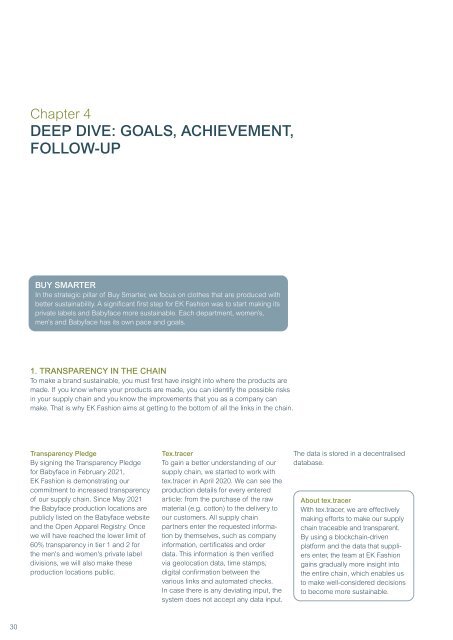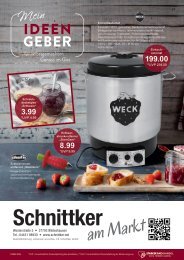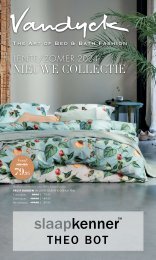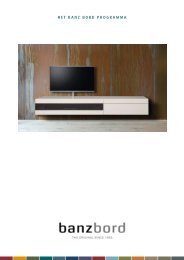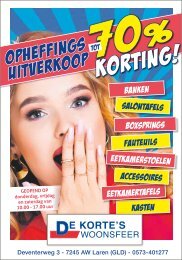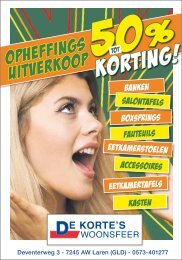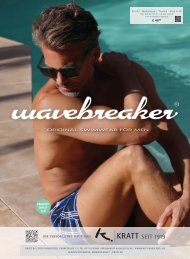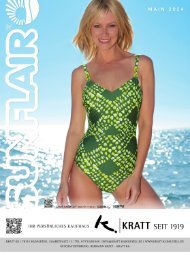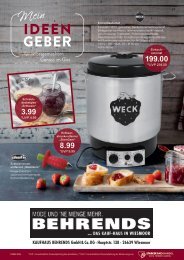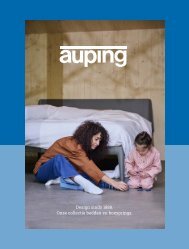EK Fashion ESG Annual Report 2021
EK Fashion ESG Annual Report 2021
EK Fashion ESG Annual Report 2021
You also want an ePaper? Increase the reach of your titles
YUMPU automatically turns print PDFs into web optimized ePapers that Google loves.
Chapter 4<br />
DEEP DIVE: GOALS, ACHIEVEMENT,<br />
FOLLOW-UP<br />
READY-MADE GARMENT MANUFACTURERS<br />
Myanmar<br />
7.6%<br />
Menswear<br />
Bangladesh<br />
3.3%<br />
BUY SMARTER<br />
In the strategic pillar of Buy Smarter, we focus on clothes that are produced with<br />
better sustainability. A significant first step for <strong>EK</strong> <strong>Fashion</strong> was to start making its<br />
private labels and Babyface more sustainable. Each department, women’s,<br />
men’s and Babyface has its own pace and goals.<br />
1. TRANSPARENCY IN THE CHAIN<br />
To make a brand sustainable, you must first have insight into where the products are<br />
made. If you know where your products are made, you can identify the possible risks<br />
in your supply chain and you know the improvements that you as a company can<br />
make. That is why <strong>EK</strong> <strong>Fashion</strong> aims at getting to the bottom of all the links in the chain.<br />
Unfortunately, there are not yet any international standards to<br />
make transparency and traceability measurable and<br />
reportable. Therefore, <strong>EK</strong> <strong>Fashion</strong>, together with tex.tracer,<br />
has drawn up standards that we use to report on traceability<br />
and transparency. These standards consist of three levels of<br />
traceability and transparency (abbreviated to T.T levels) and<br />
a clear division of production processes into tiers. Defining<br />
production processes in tiers remains complex due to the<br />
various types of supply chains. Nevertheless, the established<br />
tiers help to set clear goals.<br />
T.T Levels<br />
- T.T Level 1: the supply chain partner is known to<br />
<strong>EK</strong> <strong>Fashion</strong> but has not yet registered with Tex.tracer.<br />
- T.T Level 2: The concerned supply chain partner has<br />
created a tex. tracer account. This account includes<br />
information such as the partner's name, contact<br />
information, address, trade register number, product<br />
groups, etc.<br />
- T.T Level 3: the supply chain partner has uploaded<br />
and verified order information.<br />
India<br />
76.8%<br />
Babyface<br />
Germany<br />
0.3%<br />
Womenswear<br />
China<br />
89.1%<br />
China<br />
22.9%<br />
Transparency Pledge<br />
By signing the Transparency Pledge<br />
for Babyface in February <strong>2021</strong>,<br />
<strong>EK</strong> <strong>Fashion</strong> is demonstrating our<br />
commitment to increased transparency<br />
of our supply chain. Since May <strong>2021</strong><br />
the Babyface production locations are<br />
publicly listed on the Babyface website<br />
and the Open Apparel Registry. Once<br />
we will have reached the lower limit of<br />
60% transparency in tier 1 and 2 for<br />
the men's and women's private label<br />
divisions, we will also make these<br />
production locations public.<br />
Tex.tracer<br />
To gain a better understanding of our<br />
supply chain, we started to work with<br />
tex.tracer in April 2020. We can see the<br />
production details for every entered<br />
article: from the purchase of the raw<br />
material (e.g. cotton) to the delivery to<br />
our customers. All supply chain<br />
partners enter the requested information<br />
by themselves, such as company<br />
information, certificates and order<br />
data. This information is then verified<br />
via geolocation data, time stamps,<br />
digital confirmation between the<br />
various links and automated checks.<br />
In case there is any deviating input, the<br />
system does not accept any data input.<br />
The data is stored in a decentralised<br />
database.<br />
About tex.tracer<br />
With tex.tracer, we are effectively<br />
making efforts to make our supply<br />
chain traceable and transparent.<br />
By using a blockchain-driven<br />
platform and the data that suppliers<br />
enter, the team at <strong>EK</strong> <strong>Fashion</strong><br />
gains gradually more insight into<br />
the entire chain, which enables us<br />
to make well-considered decisions<br />
to become more sustainable.<br />
Tiers:<br />
- Tier 0: Logistics (transport/importers/storage), agents.<br />
- Tier 1: Assembly factories: cutting, sewing, assembling<br />
and packing for shipment.<br />
- Tier 2: Processing facilities: fabric production: printing,<br />
dyeing, washing/washing, embroidery.<br />
- Tier 3: Processing facilities: yarn spinning, knitting and<br />
weaving.<br />
- Tier 4: Raw material suppliers: cotton cultivation,<br />
farming, livestock farms.<br />
Ready-Made Garments (RMG)<br />
manufacturers provide finished textile products that can<br />
be bought in shops or online and are ready to wear.<br />
Italy<br />
54.6%<br />
Macedonia<br />
0.3%<br />
India<br />
3.6%<br />
China<br />
24.9%<br />
Turkey<br />
14.4%<br />
Bangladesh<br />
2.1%<br />
Greece<br />
0.2%<br />
30 31


